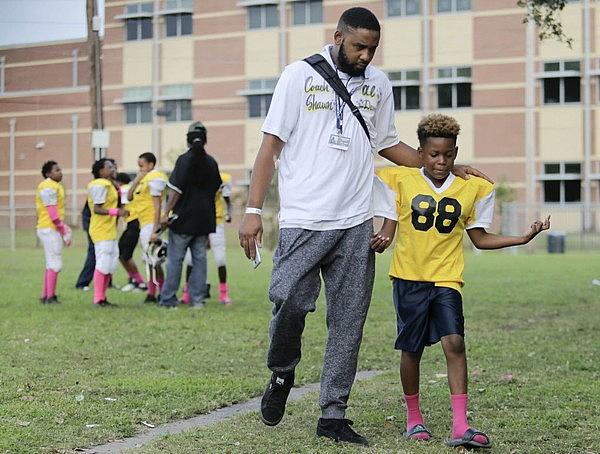More rescue efforts are needed in Central City | Opinion
This article was produced as a project for the Dennis A. Hunt Fund for Health Journalism, a program of the USC Annenberg Center for Health Journalism.

Coach Edgarson Scott walks with Philip Hall as the A.L. Davis Park Panthers 9- and 10-year-old youth football team meets up at the Central City park before heading to a game at Harrell Park on Saturday, October 21, 2017. (Photo by Brett Duke, Nola.com | The Times-Picayune)
By Jarvis DeBerry, columnist
Wednesday morning, as I was sitting in my car reading "The Children of Central City," a package of stories by NOLA.com | The Times-Picayune about what constant exposure of violence is doing to the brains of our city's children, I looked up to see two men and a woman down on their hands and knees on Felicity Street. They were trying to coax a tuxedo kitten that was trembling and retreating beneath a Toyota Camry.
The three put quite a bit of time into their rescue effort, more time than I had to sit and watch. But I did notice that when the three were temporarily distracted the kitten crept toward the rear bumper of the car as if to escape its presumed enemies. But the people regained focus and saw the kitten moving out. The accompanying shift in their posture -- their attempt to make the kitten feel good about moving toward them -- spooked the feline and caused it to retreat back into the dark beneath the car.
It wouldn't surprise me if one of the three rescuers eventually nabbed the kitten only to get scratched or bitten. I can imagine the kitten lashing out, believing that lashing out was necessary to survive.
I recognize the danger in the analogy that I'm making. Too many people are already inclined to think of the children of Central City in particular and poor black children in general as wild, as feral, as being insufficiently raised and nurtured. Just last week, for example, a business owner complaining about a group of two 9-year-olds, two 14-year-olds and a 15-year-olds arrested after a crime spree in the Marigny and Bywater neighborhoods, told WWL-TV, "Some of them are just born bad."
No, they're not. And all of us should categorically reject that kind of thinking.
So when I contrast the collaborative effort that went into trying to save that kitten in Central City to the general indifference surrounding children in that and other beleaguered neighborhoods, I do so cautiously. I don't want to endorse the idea that our children -- however troubled -- are less than human, less than civilized.
My hope is that we'll see that the children are in need of help, in need of at least as much help as that kitten. What if we thought of children who lash out and engage in destructive and anti-social behaviors not as inherently dangerous -- not as "born bad," as the Marigny business owner put it -- but as immature souls who have come to believe that causing others to bleed is necessary to make it?
My friends at the Institute of Women and Ethnic Studies (IWES) have been on an extended campaign to get New Orleans to see and acknowledge the pain so many of our children have experienced in their short lives. The hope is that when we acknowledge our children's pain that we will learn to think of them as "sad, not bad."
How we describe the problem determines what we say the solutions are. If we think of our children as bad, then the obvious solutions will include school suspensions and expulsions, more juvenile jails and detention facilities. If we think of them as sad, then the prescription will include mental health treatment, a deployment of social workers, trauma-informed care, and a more urgent commitment to ridding those children's neighborhoods of the crime and violence that continue to traumatize them.
IWES reported in 2014 that children they studied in New Orleans had a high rate of post-traumatic stress disorder four times the national average. That abnormally high rate of PTSD is related to the amount of violence children in the city have seen.
Earl Watson, whose then 5-year-old son saw a woman shoot a man dead in the parking lot of a Church's Chicken in 2014, said after that, "If a fire truck came through with the sirens, he'd come inside running. He'd be crying, hysterical. His nerves are real bad. He chews off the skin to his fingers."
We can imagine that child -- and other children who've witnessed bloodshed -- cowering under some piece of furniture, desperate for some kind of cover and protection.
They won't be able to help themselves out of that situation. They'll need help.
As we read the stories and watch the videos that make up "The Children of Central City," we should appreciate the many professionals and volunteers who are trying to rescue as many children as they can.
Jerome Temple is most famous as bounce music pioneer DJ Jubilee, but his most meaningful work may have been coaching The Panthers, a youth football team based at A.L. Davis Park.
"You only have a small window when you can reach them," Temple says. "All the elements out there is waiting for them, the drugs and guns and killing. All that negativity. It gets scary."
We shouldn't think of this problem solely in terms of how scary it is for us. We should think about how scary it is for the children.
Jarvis DeBerry is deputy opinions editor for NOLA.COM | The Times-Picayune. He can be reached at jdeberry@nola.comor at twitter.com/jarvisdeberry.
[This story was originally published by NOLA.com | The Times-Picayune.]

